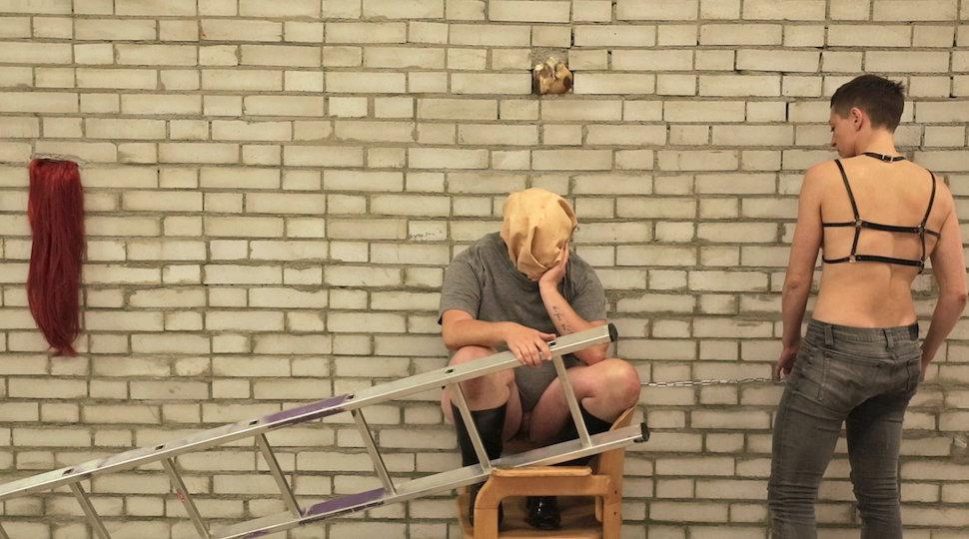Everything Fits In The Room
Simone Aughterlony & Jen Rosenblit with Miguel Gutierrez and Colin Self
presented by Gibney Dance & American Realness 2018
January 12-14, 2018
The room (to take the work’s title at face value) is in question in more senses than one. “Is this a construction site or a cooking show?” ask the creators, Simone Aughterlony and Jen Rosenblit, in a statement found on each of their websites. Further possibilities presented themselves to my mind while witnessing the performance: terrarium, hospice, hunting lodge, BDSM club, unconventional day spa. Sites of tactility, corporeality, assembly and disassembly. Containers for a charged intimacy between bodies, between objects, and between the two.
The room is in fact replete with things, scattered about the space or affixed to a free-standing wall at its center. An aluminum ladder, a large plastic tub, some evergreen branches, swaths of fabric and fur, chains, chairs, a pile of bones. There is an installation (by Florian Bach) of multi-colored neon tube lights. There is also a mobile DJ-booth-cum-kitchen-island (complete with hot plate and stovetop espresso pot), trailing a thick power cable behind it like a tail, which serves as the base of operations for composer/performers (“soundbodies” as the program has it) Miguel Gutierrez and Colin Self. Moving around and amongst it all are Aughterlony, Rosenblit, and guest performer Niall Noel Jones, rearranging and recontextualizing themselves and the objects in relationship to one another and to their environment (both physical and aural).
The room holds acts of domesticity rendered uncanny, as when Aughterlony bends Rosenblit over the evergreen bundle and washes her body with a pink grapefruit, or Gutierrez attempts to serve Rosenblit an espresso while her entire head is covered by fabric. It holds moments of danger that might turn ecstatic, as when the three dancers gleefully entangle themselves, various unwieldy objects, and the wall in a kinetic mesh of rope; or turn mundane, as when Rosenblit does a headstand in the tub, her face submerged in dirty water, then rights herself and sits down in the tub unfazed. The room facilitates cohabitation rather than opposition: flesh with concrete, desire with decay. Bruises and scrapes cover the performers’ bodies. Tenderness abounds.
And the room holds space for the spectator as well. Free to move about and position ourselves at will in relation to objects and actions alike, our own bodies and our own desires become another element of the performance’s living architecture. We gather in groups and look on together, or else we spot something of interest in the opposite corner of the room and follow up on our own, and these dynamics of proximity become an inextricable part of our response. I witnessed one intimate exchange between Aughterlony and Rosenblit from halfway across the space with no one else nearby, and another from steps away in the midst of a crowd. Both will stay with me for a long time. Many other events I did not see; the space and the performance are organized in such a way that it is impossible to take in everything. And there is a relation there too, between my experience of the piece and that of another spectator, or that of one of the performers. This is a kind of (dis)assembly, a kind of cohabitation, and a kind of care. This, too, fits in the room.
Photo: Jorge León

